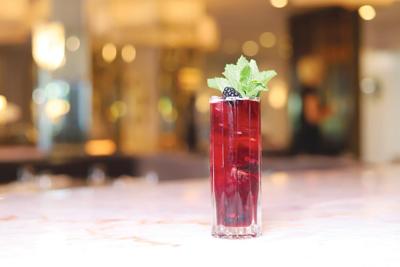When it comes to everyday hydration, hibiscus tea ranks high on my list for flavorful, satisfying sipping. Slightly tart and naturally refreshing, its deep ruby hue alone makes it feel special, and a quick squeeze of citrus adds a little zing as it transforms the color from red to pink.
Also a fantastic base for zero-proof cocktails, hibiscus is a star ingredient in four recipes from our book, “CRAFT: The Eat Fit Guide to Zero Proof Cocktails.” While you can absolutely use store-bought hibiscus tea (until recently, that’s how I’ve always made hibiscus tea), if you happen to have access to a hibiscus plant blooming near you, it can be incredibly satisfying to make hibiscus tea straight from the plant.
It’s not just any hibiscus, though. And it’s not the petals that are steeped, but instead the ruby-red calyxes that hold the flowers.��
Hibiscus Roselle, also known as Flor de Jamaica, is the variety of hibiscus that’s used to make hibiscus tea, says Linda Franzo, owner of Passionate Platter cooking school and a member of the New Orleans Herb Society. The calyxes are the bulb-like parts that attach Hibiscus Roselle’s small white flowers to its deep red stems.
Health benefits and what to keep in mind
Beyond its vivid color and taste, hibiscus tea can help support healthy blood pressure levels when sipped regularly, helping to bring both systolic and diastolic numbers down a notch. Most of the studies that reported such findings used 2-3 cups a day for anywhere from two weeks to three months, with very few reports of negative side effects.
Like many other herbal teas, hibiscus tea is also rich in plant compounds that can help protect cells from oxidative stress, an imbalance of free radicals that can lead to cell damage and may play a role in conditions like cancer, Alzheimer’s and heart disease.
That said, if you’re taking medications— particularly for blood pressure or diabetes —check with your healthcare provider before making hibiscus tea a daily drink. And if you’re pregnant or nursing, it’s best to skip the hibiscus tea for now—or at least discuss it with your physician first.
Picking your calyxes
If you have access to fresh Hibiscus Roselle plants, first make sure they haven’t been treated with pesticides or other chemicals.
The best time to harvest is after the flowers fall off but before the calyxes dry out, says Franzo. First, pull the calyx from the stem and remove the hard green seed pod from inside the calyx. (You can save the seeds for next season.) Rinse each calyx to remove dust and dirt before steeping.
You might find dried calyxes available for purchase at specialty tea shops and grocery stores (e.g. Ideal Market), as well as at some supermarkets and health food stores.
How to steep
- 2 cups boiling water
- 6-8 fresh hibiscus calyxes (or 2 tablespoons dried hibiscus calyx)
- 1 teaspoon fresh lemon or lime juice (more to taste)
Place the calyxes in a large mason jar, heatproof pitcher or teapot with an infuser. Pour in the boiling water and steep for about 7 to 10 minutes—enough time to draw out the flavor without becoming bitter.
Strain to remove the calyxes, then add lemon or lime juice. Serve hot or allow to cool and serve over ice.
Fun science fact: When you add a splash of lemon or lime, you’ll see the deep-red tea immediately shift to a gorgeous pink hue. This color change happens when the acidity in citrus juice interacts with the pigments in the hibiscus—particularly the antioxidant-rich anthocyanins.
Serving ideas
Infusions: Change up the tea’s flavor profile with ingredients like fresh basil, mint, lemongrass or lemon zest, adding in just after the hibiscus tea is removed from the heat.
Zero-proof cocktails: Use hibiscus tea in place of juice or soda in your favorite zero proof cocktail recipes—or make one of the drinks from “CRAFT: The Eat Fit Guide to Zero Proof Cocktails.”
Popsicles: Freeze cooled hibiscus tea (optionally sweetened) in popsicle molds for a tart, ruby-hued treat.
Molly Kimball, RD, CSSD, is a registered dietitian with Ochsner Health and founder of Ochsner’s Eat Fit nonprofit initiative. For more wellness content, tune in to Molly’s podcast, FUELED Wellness + Nutrition, and follow @MollykimballRD and @EatFitOchsner on social media.
��

